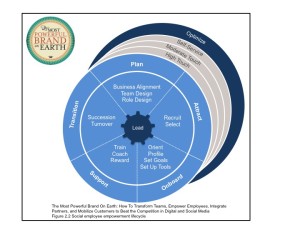Successful employee empowerment begins with a plan, yet all to often critical planning stages are overlooked, and rushing to execution is the norm. The following 3 critical planning steps are an essential foundation for a successful employee advocacy program:
Build a plan that considers:
1. Business alignment
2. Team design
3. Role design
Let’s take a look at each of these in more detail
Business Alignment
In order to understand the current state of your employees in social media, ask the following questions:
• Which business topics will your employees discuss online?
• To what extent do your employees discuss topics related to your brand in social media?
• Do they have the expertise to discuss these topics in a knowledgeable manner?
• In which venues do they discuss those topics?
• Where do they participate most actively?
• Which target audiences engage in those conversations with employees?
• Do employees represent your brand, or only themselves, when discussing the topics that matter to your brand?
• To what extent do employees publish versus listen?
• Do they have a degree of authority among the people in their online community?
• To what extent do your competitors’ employees possess authority in the same online communities?
• How would you like the above factors to change?
• How much would it be worth to your brand to change the factors above?
Answering the above questions and creating an inventory of engaged employees helps you to understand what you need to do.
As you work to determine the organizational goals that your program will support, collaborate with the leaders of the business units or functional teams that the program supports. And help them to understand how your program can help them to achieve their goals. Then determine the order in which you will take the steps to implement social media empowerment for people in their organizations.
Specifically, you will not be able to deploy this program to the entire organization at once. Instead, prioritize internal teams for enablement, and manage expectations with their leaders. Ensure that everyone understands when you will be able to support their goals and empower their people in social media.
Team Design
Once you understand the organizational goals that you need to support, you can think about how you will organize your teams to achieve those goals.
For example:
- Will you empower one person per subject area, or multiple people per subject area?
- Will you empower people in one location, or across global regions?
- How much time commitment can you expect from each participant?
This will depend largely on the extent to which their management supports their participation. To what extent will your organization’s marketing, PR, and brand staff participate in the program? Will they provide support, tools, or content to the people you empower?
Role Design
During this step, you will define the roles and domains of expertise that you wish to activate in social media. Your selection criteria should be based on your program requirements and the business outcomes you plan to support.
Employees must be segmented to determine which training, support, and tools they require and receive. Employee segmentation also determines the policies, rights, and privileges that apply to each employee. Some job roles may not be appropriate to activate or may require restrictions on their social media activity. For example, employees with access to the private data of your customers may need different tools than people with no such sensitive access.
See Chapter 6 of The Most Powerful Brand on Earth for more information about protecting the safety and security of employees, customers, and your organization.
Determine which roles in your organization are able to support brand outreach based on goals of your program and the extent to which each employee is expected or allowed to participate. Then, prioritize the segments of your employees and define the order in which you will empower each role type. For example, you might choose to empower product managers first, then product development staff, and market researchers last.
Finally, based on the information above, define the roles that socially empowered employees can play within your program. Specify how a role will be different when supporting marketing goals versus supporting recruiting goals. Perhaps they will use different tools, they may need different skills or experience, and they might set different goals for professional development.
For more detailed guidance, reference Chapter 2 of The Most Powerful Brand on Earth


